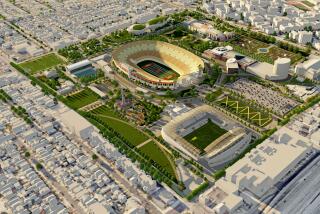O.C. Fair Board OKs 10-Year Master Plan
- Share via
Leaving the most sensitive problem unresolved--what to do with the former Pacific Amphitheatre--the Orange County Fair board unanimously approved a 10-yearmaster plan Thursday for the sprawling county fairgrounds.
The vote ends the fair’s hearing process on increasing the public’s use of its 160-acre property. The 110-year-old fair is grappling with an identity crisis: How to foster California’s agricultural legacy in an increasingly urban county while staying competitive with other entertainment venues.
The latest plan is a mix of compromises with the fair’s tenants, including people who board their horses at the fairgrounds and the 1,200 vendors at the fair’s popular weekend marketplace, which brings in a third of the fair’s $14-million yearly revenue.
Still unsettled is what the fair intends to do with the Pacific Amphitheatre, closed since 1995. The venue, which can seat 18,765, has been the subject of a long-running legal dispute with nearby residents over noise.
“That’s one of the issues we need to look at . . . along with details for other programs,” said Becky Bailey-Findley, the fair’s general manager.
One option is to eliminate 10,000 seats. The board also wants to conduct noise tests in the hope that new sound technology will enable the fair to use the facility for big-name concerts again without disturbing neighbors.
But Patrick R. Clark, a resident in nearby College Park, said he is not happy that the board bypassed area residents in favor of consulting with the Costa Mesa City Council.
“The litigation on the amphitheater was initiated by residents and not the city of Costa Mesa,” Clark reminded the board Thursday. “The board recently has notified the City Council of the changes, but the fair has not spoken directly to the homeowners.”
The amphitheater issue isn’t the number of seats but whether more concerts will be held, Clark said after the meeting.
The board intends to tackle the amphitheater and other issues early next year, said board Chairman Curt Pringle. He added that Thursday’s action puts the fair only “halfway through the planning process.”
A board subcommittee, made up of five directors, has been assigned to study the unresolved items and report their progress in January. Though many changes were voted on, some will be phased in as details are negotiated and settled, Pringle said.
The fair’s consultant, Frank Haselton of Irvine-based LSA & Associates, expects to fine-tune the master plan and is not expected to return with a final version before next summer.
Marketplace vendors said they do not know whether the fair board will move a $2-million snack bar built by the swap meet’s operator. In the approved plan, Haselton has two proposed administration buildings where the snack bar is now.
Haselton said that he has spoken with the swap meet operator, who expressed concern about the buildings. The fair staff knows that there are conflicts with the snack bar, Haselton said, and they will be resolved later.
At a previous meeting, the board approved a plan to reduce the 14-acre equestrian center’s number of stalls from 250 to 185 and to trim its training rings from five to three.
Pringle said that decision was based in part on the fair’s bid to operate the stables at the former El Toro Marine base. If successful, the El Toro stables will become a satellite of the fair’s equestrian center.
No decision will be made on the center’s size, however, until after the board’s subcommittee reports its findings in January. The size reduction also hinges on whether the fair’s bid to run the El Toro stables is successful, Pringle said.
More to Read
Sign up for Essential California
The most important California stories and recommendations in your inbox every morning.
You may occasionally receive promotional content from the Los Angeles Times.













